The difference between success and failure in Forex trading is very likely to depend mostly upon which currency pairs you choose to trade each week and in which direction, and not on the exact trading methods you might use to determine trade entries and exits.
When starting the trading week, it is a good idea to look at the big picture of what is developing in the market as a whole and how such developments and affected by macro fundamentals and market sentiment.
It is not an especially good time to be trading markets right now, as there are only a few valid long-term trends to exploit.
Big Picture 6th June 2021
Last week’s Forex market saw the strongest rise in the relative value of the Australian dollar and the strongest fall in the relative value of the New Zealand dollar. However, the values were so small as to be practically irrelevant. It was a quiet week in the Forex market.
I wrote in my previous piece last week that the best trades were likely to be being short of the USD/CAD and USD/ZAR currency pairs, and long of gold in USD terms. The USD/CAD currency pair rose by 0.02%, while the USD/ZAR currency pair fell by 2.64%. Gold in USD terms fell by 0.63% over the week. Overall, these were good calls, as they produced an averaged win of 0.67%.
Fundamental Analysis & Market Sentiment
The headline takeaway from last week was the weaker than expected non-farm payrolls report in the US. This sent the U.S. dollar somewhat lower, while pushing WTI Crude Oil to a new long-term high and the major S&P 500 Index very near to a new all-time high price. We are seeing a mixed picture across other markets, with fewer clear trends surviving. The Canadian dollar and the British pound have the greatest long-term strength amongst major currencies.
Last week saw the new U.S. and Canadian job prints come in lower than expected, while Australian GDP was revealed to be growing faster than expected.
The main events this coming week will be major monthly policy inputs from the European Central Bank and the Bank of Canada, plus key U.S. CPI (inflation) data. These releases are likely to ensure that the coming week is more volatile than last week was.
Last week saw the global number of confirmed new coronavirus cases and deaths fall for the fifth week running, suggesting that the recent wave which saw a new record daily high has peaked globally. It is likely that the extensive vaccination campaigns seen mostly in more advanced economies has contributed significantly to this situation.
Excepting extremely small nations, the fastest progress towards herd immunity has taken place in Israel, the U.K. and the U.A.E. Immunization is now proceeding more quickly in the European Union than it is in the U.S. although the U.S. is ahead of the E.U. with 51% of its population having received at least one shot of a vaccine, while the E.U. has vaccinated 40% of its population. Some nations are about to begin vaccinating older children.
The strongest growth in new confirmed coronavirus cases right now is happening in Afghanistan, Algeria, Bangladesh, Cambodia, Colombia, Dominican Republic, Fiji, Haiti, Kuwait, Malaysia, Mongolia, Oman, Philippines, South Africa, Sri Lanka, Tunisia, and Vietnam.
Technical Analysis
U.S. Dollar Index
The weekly price chart below shows the U.S. Dollar Index printed a bearish pin/doji candlestick last week. This is a bearish sign, as is the fact that the price action is still respecting the resistance level identified at 11716. The index is still below its prices from both six and three months ago, which shows a long-term bearish trend persists in the greenback. Overall, next week’s price movement in the U.S. dollar looks more likely to be downwards than upwards. Much is likely to depend upon whether the resistance level at 11716 holds. This suggests that trades short of the USD are likely to be appropriate next week.
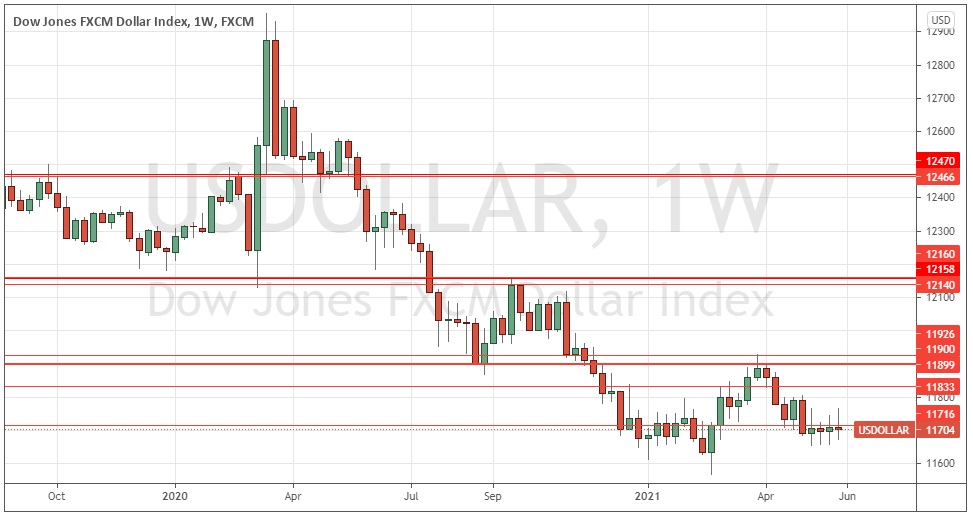
USD/CAD
Although the Canadian dollar does not have a good track record of respecting its own price momentum, the chart below shows we have seen a firm and persistent long-term bullish trend in the Loonie ever since the initial recovery from the coronavirus price shock of March 2020. Despite the strong long-term bearish trend, bears should be cautious of the big round number at 1.2000, which was almost touched last week. Bears should also be cautious of the fact that last week’s price range was very narrow, so it will probably be worth waiting for the price to get established below both the low and the big round number at 1.2000 before attempting to enter any short trades.
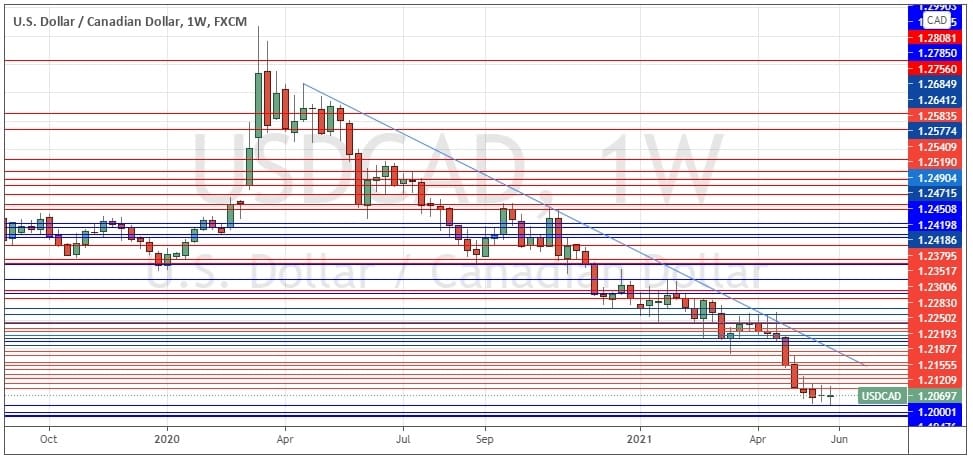
USD/TRY
The Turkish lira for years now has suffered from an established status as a permanently weakening basket case of a currency as markets have little confidence in the ability of the Turkish central bank to operate effectively. Last week, the currency made another all-time low before this currency pair ended the week at a record high weekly close.
This currency pair makes a tempting target, but spreads and overnight financing fees are high so it should only be traded with caution. The price is also often prone to strong bearish retracements which happen very suddenly. Traders looking to be short of the Turkish lira need to be extremely careful and pick their timing precisely.
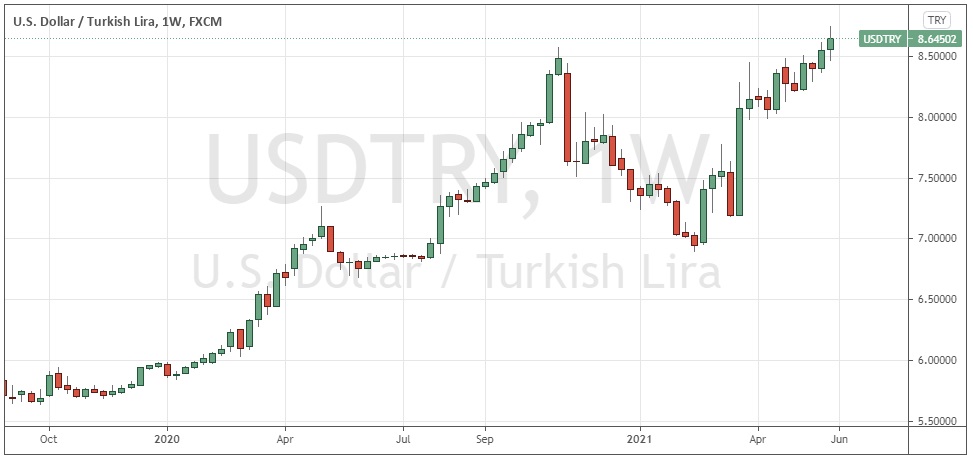
USD/ZAR
Although the South African rand does not have a good track record of respecting its own price momentum, the chart below shows we have seen a firm and persistent long-term bullish trend in the rand ever since its initial recovery from the coronavirus price shock of March 2020. There is a strong long-term bearish trend, with healthy bearish momentum over the past week which again pushed the price down to a new 2-year low price. The price of this currency pair looks likely to fall further over the coming week.
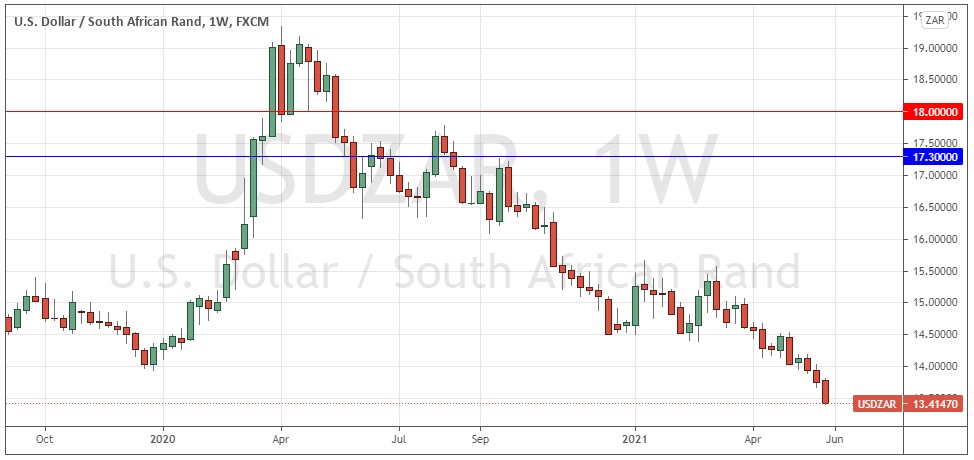
WTI Crude Oil
Although WTI Crude Oil does not have a good track record of respecting its own price momentum, the chart below shows we have seen a firm and persistent long-term bullish trend in crude oil ever since the initial recovery from the coronavirus price collapse seen in April 2020. Despite the strong long-term bullish trend, bulls should be cautious of the big round number at $70, which was almost touched last week. However, continuing strong post-corona economic growth in many major economies is fueling demand for WTI Crude Oil, so this may be a worthwhile buy again over the coming week.
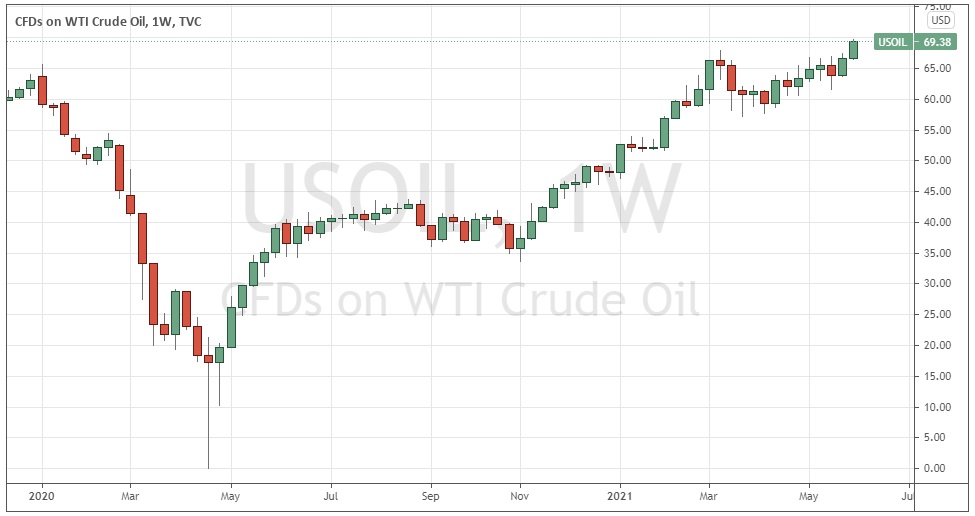
Bottom Line
I see the best likely opportunities in the financial markets this week as being short of the USD/CAD currency pair following a daily (New York) close below 1.2000, and of the USD/ZAR currency pair.
